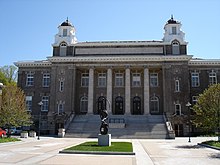"Every government has its think tanks."
While the term "think tank" with its present sense originated in the 1950s,[citation needed] such organizations date to the 19th century. The Institute for Defence and Security Studies (RUSI) was founded in 1831 in London. The Fabian Society in Britain dates from 1884.
The original Washington think tank, Brookings Institution was founded in Washington, D.C. in 1916 by philanthropist Robert Brookings. It was conceived as a bipartisan "research center modeled on academic institutions and focused on addressing the questions of the federal government."
After 1945, the number of policy institutes increased, as many small new ones were formed to express various issue and policy agendas. Until the 1940s, most think tanks were known only by the name of the institution. During the Second World War, think tanks were often referred to as "brain boxes" after the slang term for skull. The phrase "think tank" in wartime American slang referred to rooms where strategists discussed war planning. Later the term "think tank" was used to refer to organizations that offered military advice—such as, perhaps most notably, the RAND Corporation, founded originally in 1946 as an offshoot of Douglas Aircraft Corporation, and which became an independent corporation in 1948.
For most of the 20th century, independent public policy institutes that performed research and provided advice concerning public policy were found primarily in the United States, with a much smaller number in Canada, the UK and Western Europe. Although think tanks existed in Japan for some time, they generally lacked independence, having close associations with government ministries or corporations. There has been a veritable proliferation of "think tanks" around the world that began during the 1980s as a result of globalization, the end of the Cold War, and the emergence of transnational problems. Two-thirds of all the think tanks that exist today were established after 1970 and more than half were established since 1980.
The effect of globalization on the proliferation of think tanks is most evident in regions such as Africa, Eastern Europe, Central Asia, and parts of Southeast Asia, where there was a concerted effort by the international community to assist the creation of independent public policy research organizations. A recent survey performed by the Foreign Policy Research Institute’s Think Tanks and Civil Societies Program underscores the significance of this effort and documents the fact that most of the think tanks in these regions have been established during the last 10 years. Presently there are more than 4,500 of these institutions around the world. Many of the more established think tanks, having been created during the Cold War, are focused on international affairs, security studies, and foreign policy
"They {Latin American Nations] were protected by a wall, a wall built by the United States and called the Monroe Doctrine."
The Monroe Doctrine was a policy of the United States introduced on December 2, 1823. It stated that further efforts by European nations to colonize land or interfere with states in North or South America would be viewed as acts of aggression, requiring U.S. intervention. At the same time, the doctrine noted that the United States would neither interfere with existing European colonies nor meddle in the internal concerns of European countries. The Doctrine was issued at a time when nearly all Latin American colonies of Spain and Portugal had achieved or were at the point of gaining independence from the Portuguese and Spanish Empires; Peru consolidated their independence in 1824, and Bolivia would become independent in 1825, leaving only Cuba and Puerto Rico under Spanish rule. The United States, working in agreement with Britain, wanted to guarantee that no European power would move in.
President James Monroe first stated the doctrine during his seventh annual State of the Union Address to Congress. The term "Monroe Doctrine" itself was coined in 1850.By the end of the nineteenth century, Monroe's declaration was seen as a defining moment in the foreign policy of the United States and one of its longest-standing tenets. It would be invoked by many U.S. statesmen and several U.S. presidents, including Theodore Roosevelt, John F. Kennedy, Lyndon B. Johnson, Ronald Reagan and many others.
The intent and impact of the Monroe Doctrine persisted with only minor variations for more than a century. Its primary objective was to free the newly independent colonies of Latin America from European intervention and avoid situations which could make the New World a battleground for the Old World powers, so that the U.S.A. could exert its own influence undisturbed. The doctrine asserted that the New World and the Old World were to remain distinctly separate spheres of influence, for they were composed of entirely separate and independent nations However, the policy became deeply resented by Latin American nations for its overt interventionism and perceived imperialism.
"You should have your KGB agents read the Ismailians."
Couldn't find a book called The Ismailians. Below is some info from a website called www.alamut.com
From: http://www.alamut.com/subj/ideologies/alamut/etymolAss.html
In the early 11th century, al-Hassan became the head of the Persian sect of the Ismailians, a rather obscure party of fanatics which gained local power under his guidance. In 1090, al-Hassan and his followers seized the castle of Alamut, in the province of Rudbar, which lies in the mountainous region south of the Caspian Sea. It was from this mountain home that he obtained evil celebrity among the Crusaders as "the old man of the mountains", and spread terror through the Mohammedan world.
In the account given by Marco Polo in "The Adventures [or Travels] of Marco Polo" it is told that "The Old Man kept at his court such boys of twelve years old as seemed to him destined to become courageous men. When the Old Man sent them into the garden in groups of four, ten or twenty, he gave them hashish to drink. They slept for three days, then they were carried sleeping into the garden where he had them awakened.

